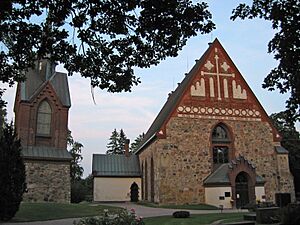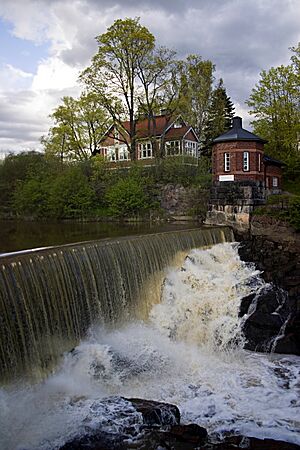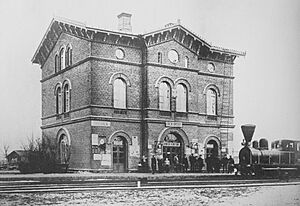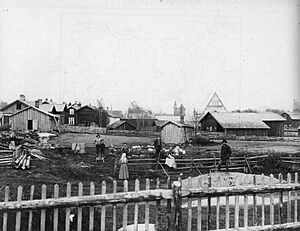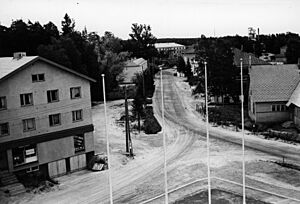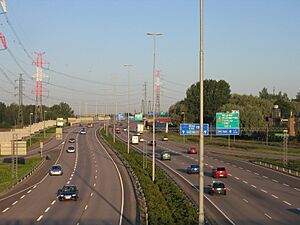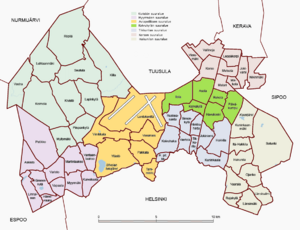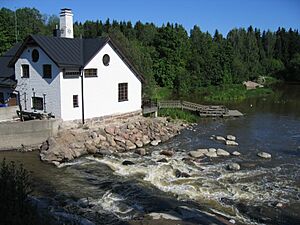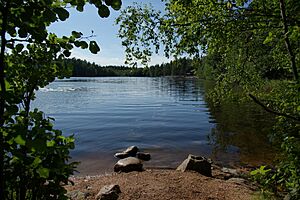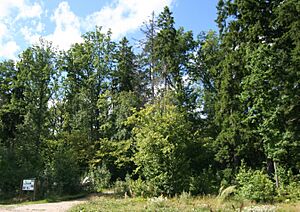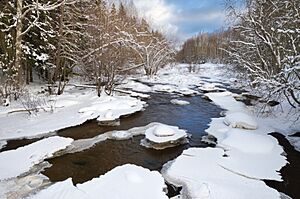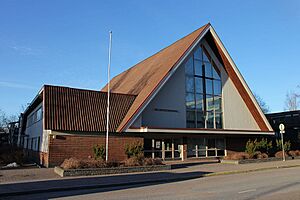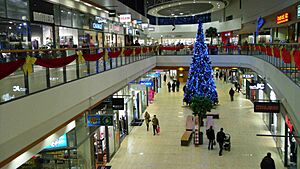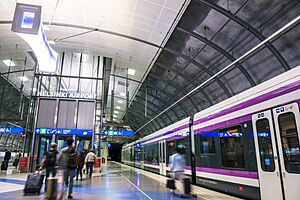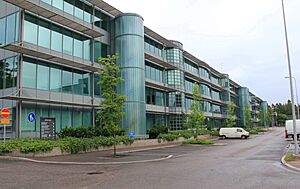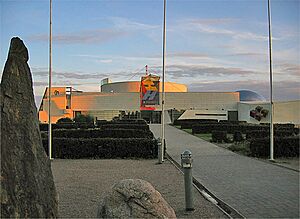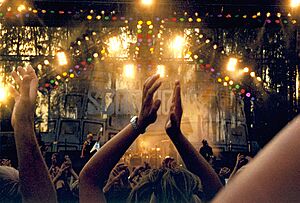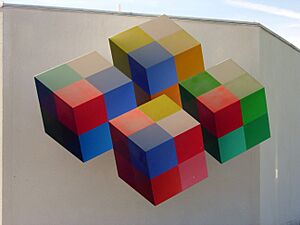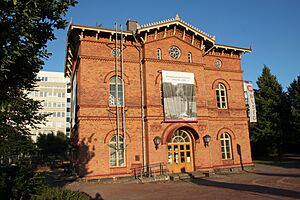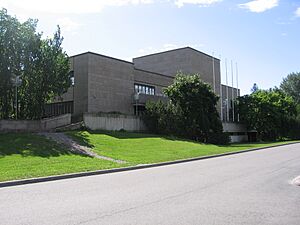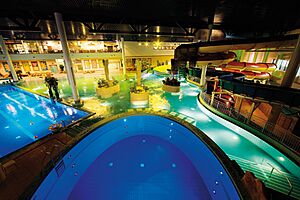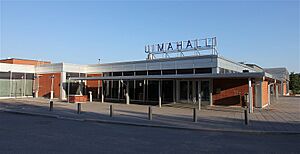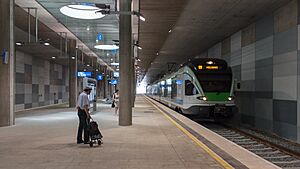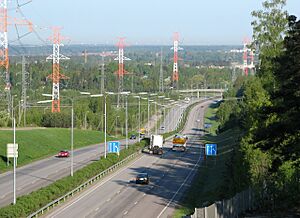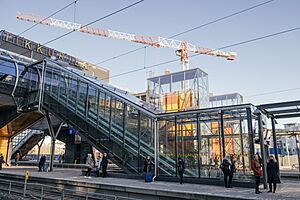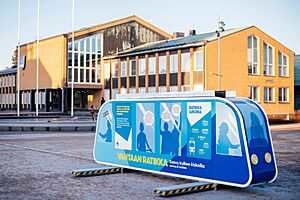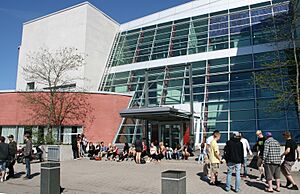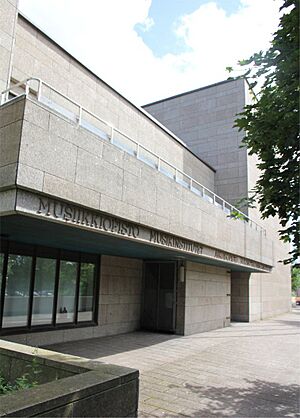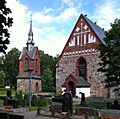Vantaa facts for kids
Quick facts for kids
Vantaa
Vantaa – Vanda
|
||
|---|---|---|
|
City
|
||
| Vantaan kaupunki Vanda stad City of Vantaa |
||
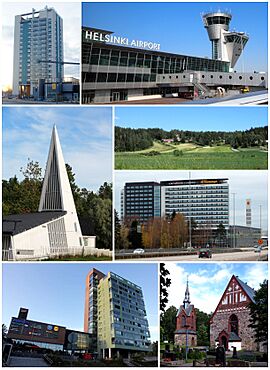
Clockwise from top-left: Kielotorni in Tikkurila, Helsinki Airport, Sotunki, Flamingo and Jumbo shopping centers, the Church of St. Lawrence, Ostari shopping center in Martinlaakso, and the Vaarala Church.
|
||
|
||
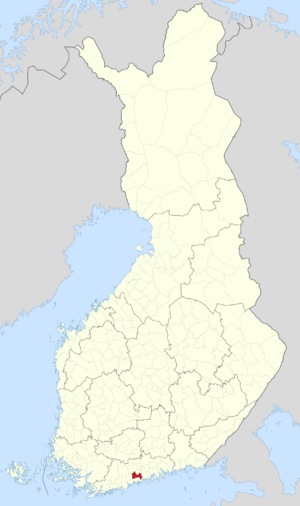
Location of Vantaa in Finland
|
||
| Country | ||
| Region | ||
| Sub-region | Helsinki sub-region | |
| Metropolitan area | Helsinki metropolitan area | |
| Charter | 1351 | |
| Köping | 1972 | |
| City | 1974 | |
| Seat | Tikkurila | |
| Major hubs | Aviapolis, Hakunila, Kivistö, Koivukylä, Korso, Myyrmäki | |
| Area
(2018-01-01)
|
||
| • Total | 240.35 km2 (92.80 sq mi) | |
| • Land | 238.38 km2 (92.04 sq mi) | |
| • Water | 1.97 km2 (0.76 sq mi) | |
| Area rank | 250th largest in Finland | |
| Population
(2023-12-31)
|
||
| • Total | 247,443 | |
| • Rank | 4th largest in Finland | |
| • Density | 1,038.02/km2 (2,688.5/sq mi) | |
| Population by native language | ||
| • Finnish | 70.9% (official) | |
| • Swedish | 2.2% (official) | |
| • Others | 26.9% | |
| Population by age | ||
| • 0 to 14 | 17.2% | |
| • 15 to 64 | 67.3% | |
| • 65 or older | 15.5% | |
| Time zone | UTC+02:00 (EET) | |
| • Summer (DST) | UTC+03:00 (EEST) | |
| Unemployment rate | 7.8% | |
| Climate | Dfb | |
Vantaa (Swedish: Vanda) is a large city in Finland. It is located just north of the capital city, Helsinki, in southern Uusimaa. Vantaa is the fourth largest municipality in Finland by population. About 247,000 people live here.
Vantaa is part of the Helsinki Metropolitan Area. This larger area has about 1.58 million people. The main center of Vantaa is in the Tikkurila district.
Vantaa shares borders with Helsinki to the south and Espoo to the southwest. Other neighbors include Nurmijärvi, Kerava, Tuusula, and Sipoo. The city covers 240.35 square kilometres (92.80 sq mi), with a small part of that being water.
The Vantaa River flows through the city. The Helsinki Airport is also located in Vantaa. It is the biggest airport in Finland. Many important companies have their main offices in Vantaa, such as Finnair and Finavia. Vantaa is also home to Heureka, a fun science center.
Vantaa is a bilingual city, meaning it has two official languages: Finnish and Swedish. Most people speak Finnish. A smaller group speaks Swedish. Many people also speak other languages, which is more common here than in other parts of Finland.
Contents
- Exploring Vantaa's Past: A Journey Through Time
- Vantaa's Landscape: Geography and Nature
- People and Culture in Vantaa
- Vantaa's Economy: Jobs and Industry
- Arts and Culture in Vantaa
- Vantaa's Infrastructure: Services and Transport
- Education in Vantaa: Schools and Learning Opportunities
- Famous People from Vantaa
- Vantaa's Global Connections: Twin Towns
- Images for kids
- See also
Exploring Vantaa's Past: A Journey Through Time
Vantaa has a very long history. People have lived here since the Stone Age.
Early Settlements: Life in Ancient Vantaa
Scientists have found signs of old homes from around 6700 to 6500 BCE. These homes were near the sea back then. People likely used them mostly in winter. Another ancient site from the Mesolithic period shows a graveyard-like dwelling.
During the Stone Age, people in Vantaa mainly got their food from the sea. They hunted seals and even harbour porpoises. Many Neolithic sites have been found in Jokiniemi. Permanent homes from this time have also been found in Hakkila.
Many items from the Comb Ceramic culture have been found in Vantaa. These include ancient clay figures of humans, which are about 5300 to 5500 years old. People from this era used flint for tools and knew how to use bows and arrows.
Less is known about Vantaa during the Iron Age. However, findings suggest people lived here. Remains of fireplaces and pottery from the Iron Age have been found. There are also signs of dwellings from the 10th century and smithies from the 12th and 13th centuries.
Historians believe Finnish people from Tavastia moved to the Helsinki and Vantaa area between the 11th and 14th centuries. They used the area for fishing and other activities.
Swedish Rule: From Parish to City
Before 1974, Vantaa was known as Helsingin pitäjä. This means "Parish of Helsinki". The rapids of the Vantaa River were called Helsingfors. This is where the Swedish name for Helsinki comes from. The city's coat of arms shows images from the river.
Swedish people began settling in Vantaa in the late 1200s. They called the area "new land". Permanent homes were built where rivers met in the 1300s.
The history of Helsingin pitäjä goes back to at least the 1300s. In 1351, King Magnus IV of Sweden gave fishing rights on the river Helsingaa (now Vantaa River) to a monastery. However, the first mention of Vantaa might be from 1331.
The King's Road, a route between Turku and Vyborg, has passed through Vantaa since the 1300s. This road brought attention to the area. The salmon-rich river also helped people settle here permanently.
The Helsingaa river gave its name to the whole area. The Helsinki socken (a type of parish) was formed between the 1370s and 1390s. The Church of St. Lawrence was built in 1460. It was located at a busy transport spot near the Vantaa and Kerava rivers.
In 1550, King Gustav I of Sweden decided to found the city of Helsinki at the mouth of the Helsingaa river. This was because Porvoo couldn't compete with merchants from Tallinn. However, the area never became the city center Gustav Vasa wanted.
Wars also affected Vantaa. In 1570, the 25-year Russian war caused stress and attacks. Many farms were abandoned. After the Treaty of Stolbovo in 1617, Helsinki gained rights for foreign trade. This led to large manors being built in Helsingin pitäjä to support the cavalry.
In 1640, Helsinki was moved to its current location. The Helsinki parish lost its independent status in 1652. The Great Famine of 1695–1697 caused many deaths in Vantaa. Russian troops invaded during the Great Wrath in 1713.
Things improved in the 1720s. Vantaa became an important center for early industry. Water-powered sawmills were built. These exported wood to Europe and even the Mediterranean Sea. The building of the Sveaborg fortress also needed many products from Vantaa.
Helsingin pitäjä was mostly Swedish-speaking. From the mid-1700s to early 1800s, only about one-tenth of the people spoke Finnish.
Russian Rule: Growth and Change
Ore was found in Vantaa in the 1700s. It was used when Finland came under Russian control in the early 1800s. This led to fast industrial growth. Communities grew around places like Tikkurila and Kerava. The Tikkurila area had a plant that made oil, which is now the paint company Tikkurila Oyj.
Helsinki became the capital of Finland in the early 1800s. Helsingin pitäjä became a municipality in 1865. It was then called Helsingin maalaiskunta (Rural Municipality of Helsinki). In 1805, Helsingin pitäjä had more people than Helsinki itself. But by 1865, Helsinki had grown much larger.
The first municipal law in Finland was enacted in 1865. This made Helsingin pitäjä the Rural Municipality of Helsinki. The railway center of Malmi became its administrative center.
In 1862, a railway was built between Helsinki and Hämeenlinna. One of its stations was in Tikkurila. The old station building, designed by Carl Albert Edelfelt, is the oldest station building in Finland. It is now the Vantaa City Museum. The railway brought new industries and more people.
The Finnish famine of 1866–1868 caused Vantaa's population to drop by 1300 people. It took a decade for the population to recover. The elementary school in Kirkonkylä opened in 1869.
Four important roads passed through Helsingin pitäjä in the late 1800s. These included Hämeentie and the King's Road. The King's Road connected Turku to Vyborg and Saint Petersburg.
The largest factory in the rural municipality was the Arabia porcelain factory. It made more products than all other factories combined. Brick factories were also important for building materials in Helsinki. A brewery in Pitäjänmäki made beer and other drinks until 1914.
In 1899, a law about densely populated areas came into force. Many small communities formed in Helsingin maalaiskunta. Some of these, like Huopalahti, Oulunkylä, and Kulosaari, later became their own municipalities. Most of these areas were joined to Helsinki in 1946.
Modern Vantaa: From Rural to Urban Center
Electricity became a new power source for industries before World War I. Power stations were built in Malmi and Oulunkylä. The Helsinki-Malmi Airport was built in 1936 in the Malmi area.
In 1946, a large part of Helsingin maalaiskunta was joined to Helsinki. The rural municipality lost two-thirds of its people. In 1954, some areas from Tuusula and Kerava were added to Vantaa.
Vantaa's population grew quickly after World War II. Tikkurila became the new main center in the 1950s. New neighborhoods with detached houses and apartment buildings appeared. Many people moved from rural areas to Vantaa. In 1970, Vantaa's population grew by 10,000 people.
In 1952, the new international airport opened in Vantaa for the 1952 Summer Olympics. This made Vantaa an important transport hub. The airport is now a key part of Vantaa's identity.
The Keimola Motor Stadium was built in 1966. It was a race track until 1978. Now, a new residential area is being built there.
In the early 1900s, most people in Vantaa spoke Swedish. But as the population grew, more Finnish-speaking people moved in. Today, only about 3.1% of Vantaa's population speaks Swedish.
Roads were widened in the 1960s and 1970s. The Ring III beltway was built. Myyrmäki became another important center after the Martinlaakso railway was built. New suburbs grew along the main railway lines. Some rural areas, like Seutula and Sotunki, remained less developed.
In 1972, the municipality was renamed Vantaa and became a market town. In 1974, it became a full city. The name "Vantaa" comes from the Vantaa River. In 2001, Vantaa celebrated its 650th anniversary.
The city has grown rapidly since the 1960s. A railway line was built to the western side in the 1970s. Vantaa has many suburban areas and no single city center. The Helsinki Airport is in central Vantaa.
In 2015, the Ring Rail Line opened. This new railway connects the airport and new neighborhoods. It links the Vantaankoski railway to the Finnish Main Line.
The annual Beer floating event started in Vantaa in 1997. In 2002, there was an explosion at the Myyrmanni shopping center. Peace talks for the Aceh conflict were held in Vantaa in 2005.
A new tramway is planned to open in 2030. It will connect the airport, Tikkurila, and other districts. This will be Vantaa's first tram line.
Understanding Vantaa's Name: A Look at Etymology
Swedish settlers in the 1300s named the river Helsingå or Helsingaa. This name might come from the Hälsingland area in Sweden.
The river was also known as the Vantaa River (Vanda å in Swedish). This name comes from the Finnish-speaking people living upstream. There's a village called Vantaa near the river's source. The name Vantaa might mean "behind a riverbed" in Finnish. Later, this name spread downstream and replaced Helsingaa.
The Vanhankaupunginkoski rapids were called Helsinge fors ("Helsinki rapids"). This name also inspired Helsingfors, the Swedish name for Helsinki.
The Vantaa blast furnace, built in 1837, gave the name "Vantaa" to its surroundings.
In 1865, the municipality became Helsingin maalaiskunta (Rural Municipality of Helsinki). The Swedish name stayed Helsinge. When it became a market town in 1972, it was named Vantaan kauppala. Two years later, it became the City of Vantaa.
Vantaa's Landscape: Geography and Nature
Where is Vantaa Located?
Vantaa is in southern Finland, in the region of Uusimaa. It is part of the Helsinki sub-region. Vantaa is separated from the Gulf of Finland by Helsinki.
The city borders Helsinki to the south. It also borders Espoo to the west, and Nurmijärvi, Kerava, and Tuusula to the north. Sipoo is to the east. Vantaa is part of the Finnish Capital Region.
How Vantaa is Divided: Major Regions and Districts
Vantaa is split into seven main areas called major regions. These are Tikkurila, Hakunila, Koivukylä, Korso, Aviapolis, Myyrmäki, and Kivistö. These regions are then divided into 60 smaller city districts. The most populated districts are Myyrmäki, Martinlaakso, Hakunila, and Pakkala.
Natural Wonders: Rivers, Lakes, and Forests
Vantaa has many lowlands with rivers. The city is mostly suburban and urban, but also has rural areas. These can be found in districts like Sotunki and Seutula.
The Vantaa River flows through western Vantaa. Its branch, Keravanjoki, runs through eastern Vantaa. Vantaa used to reach the sea, but lost its coastline in 2009. This made Vantaa the second largest inland city in the Nordic countries after Tampere.
Vantaa has few natural lakes. These include Kuusijärvi and Lammaslampi. There is also an artificial lake called Silvolan tekojärvi. Vantaa shares two lakes with Espoo: Odilampi and Pitkäjärvi.
The easternmost districts of Vantaa, Rajakylä and Länsimäki, are next to Helsinki. Part of the Mellunmäki metro station is actually in Vantaa.
Vantaa often has exposed granite bedrock. This is common in Finland. The last glacial period (about 10,000 years ago) shaped the land. It left behind eskers, which are good sources of groundwater. After the ice age, most of Vantaa was underwater. As the land rose, bays and the Vantaa River formed.
Plant Life: Vantaa's Flora
Vantaa is in the taiga zone, which means it has northern forests. Its plants are typical of southern Finland. Vantaa is a mix of coniferous (pine and spruce) and deciduous (leafy) forests. Deciduous trees like oaks and elms grow here.
River valleys used to have many lush groves. Now, most are farmlands. But some areas still have beautiful mixed forests. These can turn into shady spruce forests.
There are alder meadows along the Mätäoja river. They are home to rare insects and plants. The most common forest type in Vantaa has spruce and birch trees with blueberries. Dry forests are only found on bare cliffs.
Another common forest type is a lush, grove-like forest. It has plants like blueberry, wood sorrel, and lady fern. In early May, wood anemones bloom brightly in almost all groves.
A very old oak forest is in the Tammisto district. It is the only natural oak forest in the Helsinki capital area. It has been protected since 1946.
Even though Vantaa is urban, much of it is still rural fields or forest. About 5% of the city is protected nature area. The first nature preserve was in Tammisto in 1946. Two special protected species live here: the beetle Hylochares cruentatus and the orchid Malaxis monophyllos.
Vantaa's Weather: Climate and Seasons
Vantaa has a humid continental climate. This means it has four clear seasons. Rain is spread out through the year, but spring is the driest. Summers are usually warm, and winters are cold. The nearby sea and Gulf Stream make the climate milder.
The lowest temperature ever recorded in Vantaa is -35.9°C. The highest is 34.0°C.
| Climate data for Helsinki Airport (Aviapolis) (1981-2010) | |||||||||||||
|---|---|---|---|---|---|---|---|---|---|---|---|---|---|
| Month | Jan | Feb | Mar | Apr | May | Jun | Jul | Aug | Sep | Oct | Nov | Dec | Year |
| Record high °C (°F) | 8.2 (46.8) |
10.0 (50.0) |
17.5 (63.5) |
23.6 (74.5) |
28.8 (83.8) |
31.4 (88.5) |
34.0 (93.2) |
31.5 (88.7) |
25.3 (77.5) |
18.2 (64.8) |
10.5 (50.9) |
9.6 (49.3) |
34.0 (93.2) |
| Mean daily maximum °C (°F) | −2.4 (27.7) |
−2.7 (27.1) |
1.5 (34.7) |
8.7 (47.7) |
15.8 (60.4) |
19.6 (67.3) |
22.5 (72.5) |
20.5 (68.9) |
14.8 (58.6) |
8.6 (47.5) |
2.6 (36.7) |
−0.7 (30.7) |
9.1 (48.4) |
| Daily mean °C (°F) | −5.0 (23.0) |
−5.7 (21.7) |
−1.9 (28.6) |
4.1 (39.4) |
10.4 (50.7) |
14.6 (58.3) |
17.7 (63.9) |
15.8 (60.4) |
10.7 (51.3) |
5.6 (42.1) |
0.4 (32.7) |
−3.2 (26.2) |
5.3 (41.5) |
| Mean daily minimum °C (°F) | −8.1 (17.4) |
−8.9 (16.0) |
−5.4 (22.3) |
−0.2 (31.6) |
4.8 (40.6) |
9.5 (49.1) |
12.6 (54.7) |
11.3 (52.3) |
6.9 (44.4) |
2.7 (36.9) |
−2.1 (28.2) |
−6.0 (21.2) |
1.4 (34.5) |
| Record low °C (°F) | −35.9 (−32.6) |
−30.2 (−22.4) |
−27.2 (−17.0) |
−12.1 (10.2) |
−5.4 (22.3) |
−0.5 (31.1) |
4.0 (39.2) |
2.0 (35.6) |
−7.3 (18.9) |
−14.5 (5.9) |
−19.9 (−3.8) |
−29.5 (−21.1) |
−35.9 (−32.6) |
| Average precipitation mm (inches) | 54 (2.1) |
37 (1.5) |
37 (1.5) |
32 (1.3) |
39 (1.5) |
61 (2.4) |
66 (2.6) |
79 (3.1) |
64 (2.5) |
82 (3.2) |
73 (2.9) |
58 (2.3) |
682 (26.9) |
| Mean monthly sunshine hours | 38 | 74 | 131 | 196 | 275 | 266 | 291 | 219 | 143 | 84 | 37 | 26 | 1,780 |
| Source: Climatological statistics for the normal period 1981–2010 Sun and record temperatures 1981-2011 only | |||||||||||||
February is the coldest month, with an average temperature of -5.8°C. Temperatures rise quickly after that. April averages +4.0°C and May averages +10.5°C. July is the warmest month, averaging +17.7°C. Vantaa usually has 17 hot days a year, mostly in July.
Temperatures drop slower in autumn than they rise in spring. November averages +0.3°C and December -3.3°C. Vantaa's location near the Gulf of Finland makes it milder than other places at the same latitude. Snow usually covers Vantaa from late December to early April.
Spring has less rain than autumn. February to May average only 30-40 millimeters of rain. Summer gets rainier, with July to November averaging 60-80 millimeters. Total average rainfall in Vantaa is 682.9 millimeters per year.
People and Culture in Vantaa
Who Lives in Vantaa? Population and Demographics
| Historical population | ||
|---|---|---|
| Year | Pop. | ±% |
| 1805 | 4,840 | — |
| 1865 | 6,974 | +44.1% |
| 1880 | 7,819 | +12.1% |
| 1890 | 8,865 | +13.4% |
| 1900 | 11,110 | +25.3% |
| 1910 | 18,321 | +64.9% |
| 1920 | 22,368 | +22.1% |
| 1930 | 23,558 | +5.3% |
| 1940 | 31,511 | +33.8% |
| 1950 | 14,976 | −52.5% |
| 1960 | 41,907 | +179.8% |
| 1970 | 72,215 | +72.3% |
Vantaa has about 247,443 people. It is the fourth largest city in Finland by population. Vantaa is part of the Helsinki metropolitan area, the biggest urban area in Finland. About 4% of Finland's population lives in Vantaa.
A large part of Vantaa's population, 27.4%, has a foreign background. This is much higher than the national average. In 2017, 69% of adults in Vantaa had finished higher education.
The average income in Vantaa is lower than in Helsinki and Espoo, but still higher than in the rest of Finland. Housing in Vantaa is cheaper than in Helsinki and Espoo. Income levels can vary a lot between different neighborhoods. Women in Vantaa earn about 71% of men's income. Many families with children live in Vantaa, making up about 55% of all households. Women make up 50.2% of Vantaa's population.
| Year | Population |
|---|---|
| 1980 |
132,050
|
| 1985 |
143,844
|
| 1990 |
152,263
|
| 1995 |
166,480
|
| 2000 |
178,471
|
| 2005 |
187,281
|
| 2010 |
200,055
|
| 2015 |
211,206
|
| 2020 |
237,231
|
Languages Spoken in Vantaa
Population by mother tongue (2023) Finnish (70.9%) Russian (4.2%) Estonian (3.5%) Swedish (2.2%) Arabic (2.3%) Albanian (1.8%) Somali (1.4%) Other (13.9%)
Vantaa is officially bilingual, with Finnish and Swedish as its official languages. As of 2023, most people (70.9%) speak Finnish as their first language. There are 5,386 Swedish speakers, which is 2.2% of the population.
The number of Swedish speakers has stayed about the same, but their percentage has gone down due to immigration. In 1960, about 10% of Vantaa's population spoke Swedish. Vantaa has been mostly Finnish-speaking since the early 1900s.
Vantaa remains bilingual because the law says a municipality must be bilingual if 8% or 3,000 people speak the minority language. The percentage of Swedish speakers in Vantaa is the lowest among all bilingual municipalities in Finland. The highest percentage of Swedish speakers in Vantaa is in Helsingin pitäjän kirkonkylä (19.0%).
Only 25 people speak Sámi, Finland's third official language. About 26.9% of Vantaa's population speaks a language other than Finnish or Swedish as their first language. Many people are bilingual or trilingual because English and Swedish are required in school.
At least 100 different languages are spoken in Vantaa. The most common foreign languages are Russian (4.2%), Estonian (3.5%), Arabic (2.3%), and Albanian (1.8%). The number of foreign speakers is expected to grow to over 95,000 by 2035.
Immigration: A Diverse Community
| Population by country of birth (2022) | ||
| Nationality | Population | % |
|---|---|---|
| 191,609 | 78.9 | |
| 8,584 | 3.5 | |
| 6,666 | 2.7 | |
| 3,153 | 1.3 | |
| 1,990 | 0.8 | |
| 1,698 | 0.7 | |
| 1,685 | 0.7 | |
| 1,554 | 0.6 | |
| 1,249 | 0.5 | |
| 1,148 | 0.5 | |
| 1,130 | 0.5 | |
As of 2023, 67,846 people in Vantaa had a migrant background. This is 27.4% of the population. About 56,834 residents were born outside Finland.
Vantaa has the highest percentage of immigrants among major Finnish cities. This is more than three times the national average. More new residents are from other countries, which will increase this percentage in the future.
Religion in Vantaa
In 2023, the Evangelical Lutheran Church was the largest religious group. It included 47.0% of Vantaa's population. Other religious groups made up 4.5%. A large part of the population (48.6%) had no religious affiliation. The Finnish Orthodox Church had 1.2% of the population. The number of Lutheran Church members has gone down, while the number of people with no religious affiliation has gone up.
Lutheran Congregations
Vantaa has several Lutheran congregations. These include Hakunila, Hämeenkylä, Korso, Rekola, Tikkurila, and Vantaankoski. There is also a Swedish-speaking congregation called Vanda svenska församling. All these congregations form the Union of congregations in Vantaa.
Since 2016, Vantaa has also been home to the Lutheran congregation of the Holy Trinity.
Other Religious Groups
The Orthodox congregation of Helsinki is active in Vantaa. The Tikkurila Orthodox Church is located in Viertola.
Several Pentecostal congregations are in Vantaa. These include Myyrmäki Pentecostal congregation and Korso Pentecostal congregation.
The Vantaa free congregation, part of the Free Church of Finland, is in Hiekkaharju.
The Finnish branch office of the Jehovah's Witnesses is in Koivuhaka. There are two Kingdom Halls in Vantaa.
Vantaa's Economy: Jobs and Industry
City's Finances: How Vantaa Manages its Money
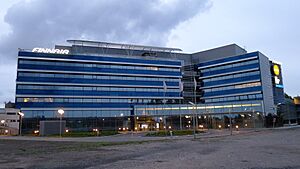
Vantaa has worked to make its economy stable. In 2016, the city managed to slightly reduce its debt, which had grown to over one billion euro.
Vantaa's debt increased in the early 2000s. This was due to less money from the state and more investments. Having many families with children also meant higher social spending. The city's income is now increasing.
Vantaa has good tax income compared to the rest of Finland. However, it's lower than in Espoo and Helsinki. The municipal tax in Vantaa is 19.00%. This is one of the lowest among large cities in Finland. Vantaa last raised its municipal tax in 2010.
In recent years, Vantaa has improved its financial situation. In the early 2000s, over half of the city's debt was from rental apartments owned by the city. The city also made large investments using borrowed money.
Work and Businesses: Vantaa's Industries
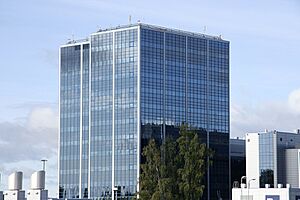
Vantaa is a major transport hub, which helps its industries. It has many food, HVAC (heating, ventilation, and air conditioning), and machinery businesses. Industrial areas are found along the Ring III beltway, especially near the airport. These include Viinikkala, Veromies, Pakkala, and Koivuhaka. Hakkila is also an industrial area connected to the main railway.
The Aviapolis area around the airport has many logistics and high-tech companies. In 2000, most jobs (74.6%) were in services. About 23.8% were in manufacturing, and only 0.5% in agriculture. In 2001, Vantaa had enough jobs for 97.1% of its working population. The number of jobs in Vantaa grew by about 15% in the 2000s.
Two-thirds of employed people work in the private sector. Key industries include food, architectural engineering, and machine industries. In 2007, the unemployment rate was 6.3%.
Companies with headquarters in Vantaa include Finnair, Finavia, and Nordic Regional Airlines (at the airport/Aviapolis). Other companies with headquarters in Vantaa are R-kioski, Tikkurila Oyj, Veikkaus Oy, and Metsähallitus. Fujifilm Finland also has its main office here.
The Ring Rail Line is expected to bring more homes and jobs to Vantaa. It provides a direct train connection to the Helsinki Airport. Helsinki has suggested joining the capital region municipalities for better development. However, Vantaa, Espoo, and Kauniainen have rejected this idea. Vantaa fears becoming a "backyard" of Helsinki.
Helsinki has expanded towards Vantaa over time. This includes a large annexation in 1946 and Vuosaari in 1966. In 2009, Vantaa lost its last connection to the sea. This happened when Östersundom and the Västerkulla wedge were annexed to Helsinki.
Arts and Culture in Vantaa
Vantaa Culture Award: Recognizing Artistic Talent
The Vantaa culture award is given every year. It recognizes important contributions to arts and culture in the city. The award goes to a person living in Vantaa or a group active in the city. It was first given in 1976.
The city council decides who receives the award. In 2015, the award was worth 10,000 euro. Past winners include jazz musician Juhani Aaltonen, singers Maarit and Sami Hurmerinta, and actor Lasse Pöysti. Other winners include the Raatikko dance theatre and writer Alpo Ruuth.
City Symbols: What Represents Vantaa?
Vantaa's special animal is the salmon. It is also on the city's coat of arms. The traditional dish is salmon soup. The city's special plant is the common dog-violet.
Music Scene: Bands, Festivals, and Orchestras
There are about 20 choirs in Vantaa, such as Vantaan Laulu. Three active concert bands are also in the city. Vantaa Pops is Finland's only professional symphonic pops orchestra. It is led by Nick Davies from Wales.
Ankkarock was a rock music festival held in Korso every summer from 1989 to 2010.
Louhela Jam is Vantaa's oldest continuous rock music festival. It's a free, one-day event held in Jokiuomanpuisto park. It takes place on the first Sunday in June.
The Tikkurila Festival is a newer summer festival. It is held in late July at the Hiekkaharju sports field.
The Vantaan barokki festival ended in 2008 after sixteen years. The Vantaan musiikkijuhlat festival started in 2010. It focuses on older music and period instruments.
The Herättäjäjuhlat festival, a religious event, was held in Vantaa in 2016.
Museums: Learning About History and Science
Tikkurila is home to Heureka, a major science centre in Finland. It opened in April 1989. Heureka aims to help people understand science. Its name comes from the Greek word for "I have found it!"
The city museum of Vantaa is in the old railway station building. It has exhibits about local history. The building was designed in 1861 and is the oldest station building in Finland. The museum moved there in 1990.
The Finnish Aviation Museum is also in Vantaa, near Helsinki Airport.
Concert House Martinus: A Place for Events
The concert house Martinus in Martinlaakso was built in 1987. It hosts many events, from meetings to cultural shows.
The concert hall has great acoustics, so it's used for many music recordings. It has also been used for television recordings. The hall has 444 seats. Martinus is the home of the Vantaa entertainment orchestra.
Myyrmäkitalo: A Hub for Activities
The Myyrmäkitalo is a multi-purpose building in western Vantaa. It has the Myyrmäki library, the Vantaa art museum Artsi, and an auditorium. The auditorium hosts the film theatre Kino Myyri.
The Vantaa school of arts and the Vantaa adult education institute use the building's facilities. Myyrmäkitalo was built in 1993. It is near the Myyrmäki railway station and the Myyrmanni shopping center.
Food Culture: Traditional Dishes
In the 1980s, salmon casserole, salmon soup, and vol-au-vent filled with salmon were chosen as Vantaa's traditional dishes.
Vantaa's Infrastructure: Services and Transport
Public Services: Healthcare and Libraries
Vantaa has seven healthcare stations. Most major districts have their own. Vantaa has two hospitals: Peijas Hospital for emergencies and short-term care, and Katriina Hospital for long-term care and elderly care.
The Vantaa branch of the HelMet network has 12 libraries. In 2011, they had over 441,000 books. The main library is in Tikkurila.
Sports and Recreation: Staying Active in Vantaa
Vantaa offers many sports facilities. It has five swimming halls and four sports halls. There are also several gyms and 25 tennis courts.
Vantaa has indoor ice rinks in Tikkurila and Myyrmäki. There are 69 outdoor hockey and skating rinks. The city also has 16 lit-up running tracks and 14 skateparks.
For golf lovers, Vantaa has three golf courses. Two 18-hole courses are in Keimola. A 9-hole course is in the Hiekkaharju sports park. Another golf course in Petikko was expanded to 18 holes in 2018.
Transportation: Getting Around Vantaa
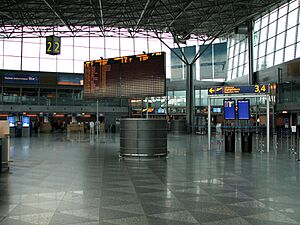
Vantaa is a major transport hub for the Helsinki metropolitan area. Several key freeways and highways pass through it. These include Ring III, Tuusulanväylä, and Porvoonväylä. Other important roads to Helsinki are Hämeenlinnanväylä, Lahdenväylä, and Vihdintie.
Public transport in Vantaa includes buses and commuter trains. These are run by HSL/HRT and VR. Since the Ring Rail Line opened in 2015, Vantaa has 14 train stations. Main railway stations also serve as central bus stations.
Vantaa has over 100 bus lines. Most are within Vantaa, while others go to Helsinki, Espoo, and Kerava.
Express bus stops are located along major roads like Hämeenlinnanväylä and Tuusulanväylä. Some stops serve buses between Helsinki Airport and other cities like Tampere, Porvoo, and Kotka.
Two of Helsinki's three railway lines go through Vantaa. The Helsinki–Riihimäki railway passes through eastern Vantaa. The Ring Rail Line forms a loop through Vantaa, connecting Helsinki, western Vantaa, the Helsinki Airport station, and Tikkurila. All long-distance trains from Helsinki stop at Tikkurila railway station.
The Ring Rail Line has stations like Vehkala, Kivistö, Aviapolis, Helsinki Airport, and Leinelä. The main railway has stations like Tikkurila railway station, Hiekkaharju, and Korso.
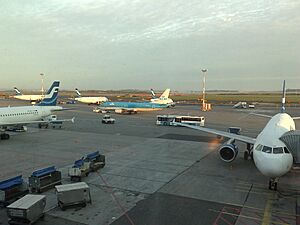
The Helsinki Airport is the largest airport in Finland. It had 18.9 million passengers in 2017. The airport divides Vantaa into eastern and western parts. The main population centers are in eastern Vantaa.
In 2019, the Vantaa city council approved plans for the Vantaa light rail. This tramway will run from Mellunmäki to the Helsinki Airport, passing through Hakunila, Tikkurila, and Aviapolis.
As a major transport hub, Vantaa experiences a lot of noise and pollution. This comes from airplanes, railways, and motorways. Over 77,000 Vantaa citizens live in areas with high noise levels.
Education in Vantaa: Schools and Learning Opportunities
Primary and Junior High Schools
Vantaa has many options for basic education. There are 50 Finnish-speaking, five Swedish-speaking, and one English-speaking primary and junior high schools. Schools vary in size. The smallest is the Swedish-speaking Kyrkoby skola, which has been in the same building since 1837. The largest primary schools have over 800 students.
Upper Secondary and Vocational Schools
Vantaa has five Finnish-speaking upper secondary schools. This includes Tikkurila Upper Secondary, the largest in the Nordic Countries. There is also one Swedish-speaking upper secondary school. Vantaa has a Steiner school for both primary and secondary education. Online education is available at Sotunki Upper Secondary.
For vocational education, Vantaa has several vocational schools. These include the Varia vocational school and the Mercuria school of business economics. These schools offer training for young people and adults. It's also possible to take the Finnish matriculation examination along with vocational education.
Higher Education: Universities of Applied Sciences
Vantaa has two universities of applied sciences: Metropolia and Laurea. Metropolia has campuses in Myyrmäki and Tikkurila. Laurea offers education in communications and social and healthcare in Tikkurila.
Other Educational Institutions
The Vantaa institution for adult education is one of Finland's largest. The Vantaa institution for arts and the Vantaa institution for music also provide education.
Learning Finnish: Support for Immigrants
It is possible to study the Finnish language in many places across Vantaa. Some courses are free, while others require payment.
Famous People from Vantaa
- Anna Abreu (born 1990), pop singer
- Mika Häkkinen (born 1968), racing driver and Formula One champion
- Lauri Markkanen (born 1997), professional basketball player
- Jere Pöyhönen (born 1993), rapper and singer
- Jarkko Ruutu (born 1975), ice hockey player
- Tuomo Ruutu (born 1983), ice hockey player
Vantaa's Global Connections: Twin Towns
Vantaa has twin towns (sister cities) around the world:
|
|
Images for kids
-
The Church of St. Lawrence (Finnish: Pyhän Laurin kirkko), the oldest church of Vantaa (c. 1460) in the Helsinki Parish Village
-
Aerial view of Helsinki Airport, located in Lentokenttä, Vantaa
See also
 In Spanish: Vantaa para niños
In Spanish: Vantaa para niños



